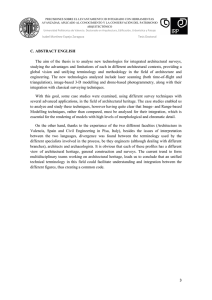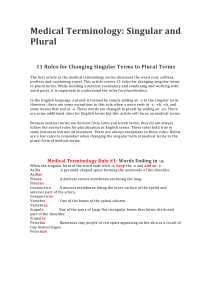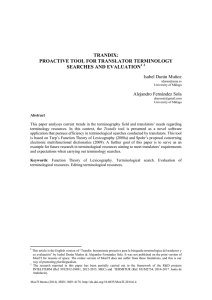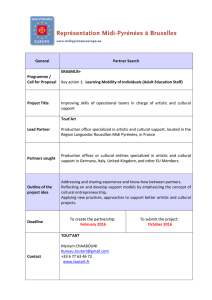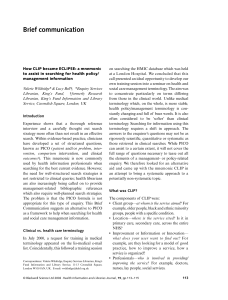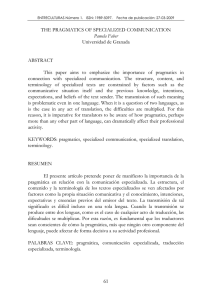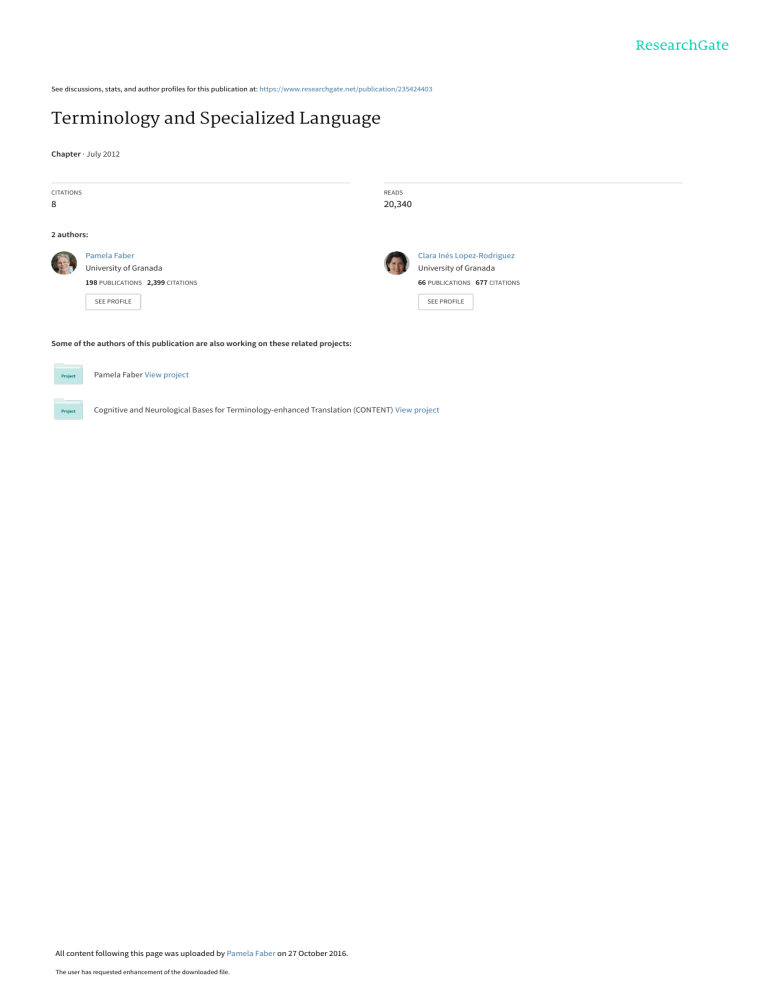
See discussions, stats, and author profiles for this publication at: https://www.researchgate.net/publication/235424403 Terminology and Specialized Language Chapter · July 2012 CITATIONS READS 8 20,340 2 authors: Pamela Faber Clara Inés Lopez-Rodriguez University of Granada University of Granada 198 PUBLICATIONS 2,399 CITATIONS 66 PUBLICATIONS 677 CITATIONS SEE PROFILE SEE PROFILE Some of the authors of this publication are also working on these related projects: Pamela Faber View project Cognitive and Neurological Bases for Terminology-enhanced Translation (CONTENT) View project All content following this page was uploaded by Pamela Faber on 27 October 2016. The user has requested enhancement of the downloaded file. 2.1. Terminology and specialized language Pamela Faber Clara Inés López Rodríguez 2.1.1. Introduction Terminology or specialized language is more than a technical or particular instance of general language. In today’s society with its emphasis on science and technology, the way specialized knowledge concepts are named, structured, described, and translated has put terminology or the designation of specialized knowledge concepts in the limelight. The information in scientific and technical texts is encoded in terms or specialized knowledge units, which are access points to more complex knowledge structures. Underlying the information in the text are entire conceptual domains, which are both explicitly and implicitly present, and which represent the specialized knowledge encoded. In order to create a specialized text, translators and technical writers must have an excellent grasp of the language in the conceptual domain, the content that must be transmitted, and the knowledge level of the addressees or text receivers. In order to translate a specialized language text, translators must go beyond correspondences at the level of individual terms, and be able to establish interlinguistic references to entire knowledge structures. Only then can they achieve the level of understanding necessary to create an equivalent text in the target language. 2.1.2. Specialized knowledge acquisition There has been a great deal of debate regarding how much a translator or technical writer really needs to know about the specialized domain in order to translate or write about a scientific or technical text. Some people even seem to believe that such texts should only be translated or written by experts in the field because, in their opinion, it is impossible for non-experts to acquire the necessary knowledge. Although it is not infrequent for experts with an acceptable level of a second language to try to write or translate texts because of their knowledge of terminological correspondences, they generally find that writing an article in another language is far from simple. Similarly, there are writers or translators who believe that their syntactic and semantic knowledge of one or more languages guarantees an adequate scientific or technical text in the same language or another language without any other previous preparation or documentation. Both endeavors can be extremely difficult to perform successfully. The reason for this lies in the fact that specialized languages are not a series of water-tight compartments. Terminological units and their correspondences possess both paradigmatic and syntagmatic structure. In other words, terms not only represent specialized concepts, but also have syntax and collocational patterns within general language. In this sense, merely knowing terminological correspondences is often not enough since such units, when inserted in context, affect the text at all levels. However, it also must be said that linguistic knowledge in itself is not a sufficient guarantee to produce an acceptable text in a specialized knowledge field. A translator or technical writer must likewise be aware of the types of conceptual entities that the text is referring to, the events that they are participating in, and how they are interrelated. This signifies that writers and translators of specialized texts must also be closet terminologists and be capable of carrying out terminological management as a means of knowledge acquisition. This is one of the reasons why an understanding of terminology and specialized knowledge representation is a key factor in successful scientific and technical text generation and translation. 2.1.3. Terminology as a discipline Terminology as a discipline of study is a relative newcomer. In fact, it came into being because of the growing need to facilitate specialized communication and translation, as well as knowledge transfer between text users belonging to different language communities and with similar knowledge levels. The theoretical proposals in this field have been mostly practice-based, and focus on the elaboration of glossaries, specialized dictionaries as well as terminological and translation resources. According to Cabré (2000a: 37), “as a subject field with explicit premises, terminology emerges from the need of technicians and scientists to unify the concepts and terms of their subject fields in order to facilitate professional communication and the transfer of knowledge”. Precisely for this reason, Terminology has been for some time a discipline in search of a theory with premises capable of accounting for specialized knowledge representation, category organization, and description, as well as the semantic and syntactic behavior of terminological units in one or various languages. Over the years, this quest for a set of theoretical principles has led terminologists to ask themselves inter alia whether Terminology should be regarded as a branch of Philosophy, Sociology, Cognitive Science, or Linguistics (to name a few). Rather than say that Terminology may stem from any or all of them, we take the position that Terminology is essentially a linguistic and cognitive activity. In this sense, terms are linguistic units which convey conceptual meaning within the framework of specialized knowledge texts. In the understanding of the nature of terms, this process of meaning transmission is as important as the concept or concepts that they designate. Terminological units are thus subject to linguistic analysis. Since this type of analysis can be carried out in a number of ways, it is necessary to choose the linguistic approach most in consonance with the object of study. Such an approach should be lexically-centered and usage-based. It should also have its primary focus on meaning and conceptual representation. As shall be seen, such is the case of theoretical approaches based on Cognitive Linguistics. In the past, Terminology and Linguistics have mostly ignored each other. In its initial phase, Terminology was interested in asserting its independence from other knowledge areas, and creating a totally autonomous discipline. This goal led terminologists to go to great lengths to emphasize differences between Terminology and Lexicology even to the extent of affirming that terms are not words. In a parallel way, linguistic theory has largely ignored Terminology, probably because specialized language has been and is often regarded as merely a special case of general language. Thus, it was not considered worthy of serious study because anything pertaining to general language was also presumed to be true of specialized language. However, interesting conclusions about specialized language, scientific translation, and language in general can be obtained when terminology is studied in its own right. As such, it is most certainly susceptible to linguistic analysis within the framework of a linguistic model. Oddly enough, some years ago this seemingly innocuous affirmation would have caused quite a hue and cry in terminological circles. The reason for this was that the first approximations to terminology had normalization as a primary objective. Great pains were taken to strive for totally unambiguous communication through standardization. This signified univocity or one-to-one reference between term and concept. The fact that the majority of terms designate concepts that represent objects in a specialized knowledge field meant that such an objective seemed possible to achieve. Nevertheless, it soon became apparent that this was more a desideratum than a realistic goal. 2.1.4. Theories of Terminology As has often been observed, terminology means many things to many people (Sager 1994: 7). Terminology is a word that can either begin with an upper or lowercase letter. When terminology begins with a small t, it refers to the units in any specialized knowledge field. When it begins with a large T, it refers to the study of specialized language. As a rule, Terminology theories can be classified as either prescriptive or descriptive. General Terminology Theory, which has the virtue of being the first theoretical proposal in this area, is essentially prescriptive in nature. As shall be seen, the theories that subsequently arose in reaction to the General Terminology Theory are descriptive, and show an increasing tendency to incorporate premises from Cognitive Linguistics since they focus on the social, communicative, and cognitive aspects of specialized knowledge units. The vision that they offer is more realistic because they analyze terms as they actually appear and behave in texts. One might say that these new theories are representative of a cognitive shift in Terminology. 2.1.4.1. General Terminology Theory Terminology as a discipline began in the 1930’s with Eugen Wüster, the author of The Machine Tool, an Interlingual Dictionary of Basic Concepts (Wüster 1968), a systematically organized French and English dictionary of standardized terms (with a German supplement) intended as a model for future technical dictionaries. This multi-volume work inspired the General Terminology Theory, and set out the initial set of principles for the compilation and description of terminological data with a view to the standardization of scientific language. The General Terminology Theory was later developed in Vienna by Wüster’s successors, who interpreted his ideas and carried on his work. Although for many years, the General Terminology Theory offered the only set of principles and premises for compiling terminological data, its view of the semantics of terminological units projected a uniformly limited representation of specialized knowledge concepts without allowing for their multidimensional nature. Needless to say, the General Terminology Theory did not attempt to account for the syntax and pragmatics of specialized language, which was not regarded as relevant. In this sense, it could not be usefully applied to translation or specialized text generation. The General Terminology Theory focused on specialized knowledge concepts for the description and organization of terminological information. Within this framework, concepts were viewed as being separate from their linguistic designation (terms). Concepts were conceived as abstract cognitive entities that refer to objects in the real world, and terms were merely their linguistic labels. As Terminology struggled to acquire a semi-independent status, a considerable amount of effort was invested in distinguishing specialized language from general language and in differentiating terms from words. This radical emphasis on differences often seemed to convey the idea that terms were not even language at all, but rather abstract symbols referring to concepts in the real world. One of the basic assertions of General Terminology Theory (Wüster 1979; Felber 1984) is that terms in specialized language are inherently different from general language words because of the monosemic reference between terms and concepts. The general claim is that a term or a specialized language unit can be distinguished from a general language word by its single-meaning relationship with the specialized concept that it designates and by the stability of the relationship between form and content in texts dealing with this concept (Pavel and Nolet 2001: 19). However, this is an extremely idealized vision of specialized communication. Even the most cursory examination of specialized language texts shows that terminological variation is quite frequent, and that such variation seems to stem from parameters of specialized communication, such as the knowledge and prestige of the speakers, text function, text content, user group, etc. The same concept can often be designated by more than one term, and the same linguistic form can be used to refer to more than one concept. Furthermore, terms have distinctive syntactic projections and can behave differently in texts, depending on their conceptual focus. This is something that happens in texts of all languages, and is a problem that translators and technical writers inevitably have to deal with. Since Wüster believed that the function of Terminology was to create and standardize names for concepts, syntax was not regarded as falling within the scope of Terminology. The General Terminology Theory also regarded Terminology as exclusively synchronic, and thus ignored the diachronic dimension of terms. Wüster’s principal objectives (in Cabré 2003: 173) were: ! “To eliminate ambiguity from technical languages by means of standardization of terminology in order to make them efficient tools of communication; ! To convince all users of technical languages of the benefits of standardized terminology; ! To establish terminology as a discipline for all practical purposes and to give it the status of a science”. Cabré (2000a: 169) rightly points out that Terminology has suffered from a lack of innovative theoretical contributions because until very recently, there has been little or no theoretical discussion or confrontation of opinions. Another possible reason for the slow development of Terminology is the lack of interest shown by specialists in other areas of knowledge, such as Linguistics: The fifth reason, which may explain the continued homogeneity of the established principles, is the lack of interest in terminology by specialists of other branches of science, for example linguistics, psychology, philosophy and history of science and even communication and discourse studies. For many years terminology saw itself as a simple practice for satisfying specific needs or as a field of knowledge whose signs had nothing to do with the signs of language. However, the 1990s brought new proposals and ideas that paved the way to integrating Terminology into a wider social, communicative, and linguistic context. According to L’Homme, Heid, and Sager. (2003), examples of such approaches are Socioterminology (Boulanger 1991; Guespin 1991; Gaudin 1993, 2003), the Communicative Theory of Terminology (Cabré 2000a, 2000b, 2001a, 2001b, 2003; Cabré et al. 1998), and Sociocognitive Terminology (Temmerman 1997, 2000, 2001, 2006). 2.1.4.2. Social and communicative Terminology theories In the early 1990’s Socioterminology and Communicative Terminology Theory appeared on the horizon as a reaction to the hegemony of the General Terminology Theory. Both theories present a more realistic view of Terminology since they base their description on how terms are actually used in communicative contexts. They describe terminological units in real discourse and analyze the sociological and discourse conditions that give rise to different types of texts. Socioterminology Socioterminology, as proposed by Gaudin (1993), applies sociolinguistic principles to Terminology theory, and accounts for terminological variation by identifying term variants against the backdrop of different usage contexts. Parameters of variation are based on the social and ethnic criteria in which communication among experts and specialists can produce different terms for the same concept and more than one concept for the same term. Pihkala (2001) points out that the socioterminological approach focuses on the social and situational aspects of specialized language communication, which may affect expert communication and give rise to term variation. According to socioterminologists, standardization is a chimera since language is in constant change. Polysemy and synonymy are inevitably present in terminology and specialized texts, and the use of one term instead of another can reflect the knowledge, social, and professional status of a group of users, as well as the power relationships between participants in the communicative interaction. It can also reflect the geographic and temporal location of the text sender or originator. Terminological variation inevitably highlights the fact that concept systems and definitions are not static. This is a reality that any theory aspiring to explanatory adequacy must deal with. In this respect, the premises of Socioterminology are closely linked to Gregory and Carroll’s (1978: 3-4) characterization of linguistic variation according to use and user even though this reference is not explicitly mentioned. Although Socioterminology does not aspire to independent theoretical status, its importance resides in the fact that it opened the door for other descriptive theories of Terminology, which also take social and communicative factors into account, and which base their theoretical principles on the way terms are actually used in specialized discourse. The Communicative Theory of Terminology Linguistics and Terminology began to draw closer to each other with the Communicative Theory of Terminology (Cabré 1999a, 1999b, 1999c, 2000a, 2000b, 2001a, 2001b, 2003; Cabré et al. 1998). This proposal is more ambitious than Socioterminology and endeavors to account for the complexity of specialized knowledge units from a social, linguistic, and cognitive perspective. According to Cabré (2003), a theory of Terminology should provide a methodological framework for the study of terminological units. She underlines the fact that specialized knowledge units are multidimensional, and have a cognitive component, a linguistic component, and a sociocommunicative component. In this respect, they behave like general language words. Their specificity resides in a series of cognitive, syntactic, and pragmatic constraints, which affirm their membership in a specialized domain. In this sense, the Communicative Theory of Terminology regards terminological units as “sets of conditions” \f “au” (Cabré 2003: 184) derived from, inter alia, their particular knowledge area, conceptual structure, meaning, lexical and syntactic structure, and valence, as well as the communicative context of specialized discourse. Cabré (2003) proposes the Theory of the Doors, a metaphor representing the possible ways of accessing, analyzing, and understanding terminological units. She compares a terminological unit to a polyhedron, a threedimensional solid figure with a varying number of facets. Similarly, a terminological unit can also be said to have three dimensions: a cognitive dimension, a linguistic dimension, and a communicative dimension. Each is a separate door through which terminological units can be accessed. Nonetheless, one’s choice of door (or focus) does not entail a rejection of the other two perspectives, which continue to reside in the background. According to Cabré, the Communicative Theory of Terminology approaches units through the language door, but always within the general context of specialized communication. At this time the Communicative Theory of Terminology is probably the best candidate to replace the General Theory of Terminology as a viable, working theory of Terminology. It has led to a valuable body of research on different aspects of Terminology such as conceptual relations, terminological variation, term extraction, and the application of different linguistic models to Terminology. This has helped Terminology as a field to get its act together, and begin to question the premises of General Terminology Theory, which previously were not open to doubt or criticism. However, the Communicative Theory of Terminology is not without its shortcomings. Despite its clear description of the nature of terminological units and the fact that it mentions a term’s “syntactic structure and valence”, the Communicative Theory of Terminology avoids opting for any specific linguistic model. The relation of the Communicative Theory of Terminology to Linguistics is more in the nature of a light flirtation with various models than a monogamous relationship with any one model in particular. Its view of conceptual semantics is also in need of clarification. Although in a very general way, the Communicative Theory of Terminology bases its semantics on conceptual representation, it is more than a little vague when it comes to explaining how such representations are created, what they look like, and what constraints they might have: Cabré (2003: 189) states that the knowledge structure of specialized discourse could be represented as a conceptual map formed by nodes of knowledge, which can be represented by different types of units of expression, and by relations between these nodes. Within this framework, terminological units are recognized as such because they represent knowledge nodes of a structure, and have a special meaning in this structure. If these factors are the prerequisites for term status, then one would think that conceptual representation, knowledge structure or ontology, and category organization would be an extremely important part of the Communicative Theory of Terminology. However, this does not seem to be the case. Another area in need of clarification in the Communicative Theory of Terminology is semantic meaning. According to this theory, a lexical unit is general by default and acquires a specialized meaning when it appears in a specific type of discourse. A terminological unit is regarded as the specialized meaning of a lexical unit since its meaning is extracted from the “set of information of a lexical unit” (Cabré 2003: 184). With this affirmation, the Communicative Theory of Terminology seems to be avoiding the question of what specialized meaning is and what its components are. The only clue provided is when Cabré (2003:190) states that terminological meaning consists of a specific “selection of semantic features according to the conditions of every speech act”, which seems to implicitly say that she is in favor of some type of semantic decomposition. However, this can only be a supposition because nothing is explicitly said about the semantic analysis of specialized language units. This is a comfortable position because it shunts any decisions in this respect back into the realm of Lexical Semantics, where there is already considerable disagreement as to the nature of word meaning and how it should be analyzed. 2.1.4.3. Cognitive-based theories of Terminology Over the last decade, linguistic theory seems to be in the process of undergoing a cognitive shift (Evans and Green 2006), which has led it to increasingly focus on the conceptual network underlying language. The fact that linguistic form cannot be divorced from meaning has led linguists to begin to explore the interface between syntax and semantics (Faber and Mairal Usón 1999). This trend is also present in the area of Terminology. Cognitive-based Terminology theories, though similar in some ways to the Communicative Theory of Terminology, also differ from it. It is not an accident that such theories have arisen largely in the context of Translation. Despite the fact that they also focus on terms in texts and discourse, they make an effort to integrate premises from Cognitive Linguistics and Psychology in their accounts of category structure and concept description. Relevant proposals in this area are Sociocognitive Terminology (Temmerman 1997, 2000, 2006) and Frame-based Terminology (Faber, Márquez Linares, and Vega Expósito 2005; Faber et al. 2006, 2007; Faber and León Araúz 2010; Faber 2011). Sociocognitive Terminology Insights from Cognitive Semantics (e.g. prototype structure and metaphor) began to have an impact on Terminology theory with the advent of Sociocognitive Terminology as proposed by Temmerman (1997, 2000). Sociocognitive Terminology concentrates on the cognitive potential of Terminology in domain-specific language and on terminological variation as related to verbal, situational, and cognitive contexts in discourse and in a wide range of communicative environments (Temmerman, Kerremans, and Vandervoort 2005). Temmerman (2000: 16) criticizes General Terminology Theory, and offers examples from the Life Sciences to demonstrate that the basic principles of the General Terminology Theory are unrealistic and incapable of describing or explaining specialized language as it is actually used in communicative situations, such as specialized translation. The Wüsterian premises questioned are the following: – Concepts have a central role in regards to their linguistic designations. – Concepts and categories have clear-cut boundaries. – Terminographic definitions should always be intensional. – Monosemic reference is the rule in terminology, where there is a one-to-one correspondence between terms and concepts. – Specialized language can only be studied synchronically. Temmerman (2000) argues that these premises are not valid, and asserts that: – Language cannot be regarded as divorced from concepts since it plays a crucial role in the conception of categories. – Many categories have fuzzy boundaries and cannot be clearly defined. – Optimal definition structure and type should not be limited to only one mode and ultimately depend on the concept being defined. – Polysemy and synonymy frequently occur in specialized language and must be included in any realistic terminological analysis. – Categories, concepts, as well as terms evolve over time and should be studied diachronically. In this sense, cognitive models play an important role in the development of new ideas. This declaration of principles is the launching pad for Sociocognitive Terminology. This theory is also in consonance with Gaudin’s Socioterminology and Cabré’s Communicative Theory of Terminology since it is descriptive rather than prescriptive, and regards terms as the starting point for terminological analysis. However, in the same way as the other approaches, it has very little to say about the syntactic behavior of terms. What makes Sociocognitive Terminology different from other theories is its emphasis on conceptual organization, and its focus on category structure from the perspective of Cognitive Linguistics. While concept systems in the General Terminology Theory are organized in terms of type_of and part_of conceptual relations, sociocognitive categories are said to have prototype structure, and conceptual representations initially take the form of cognitive models. Another significant difference is that Sociocognitive Terminology is perhaps the first and only approach to truly take on board the historical or diachronic dimension of terms Temmerman (1997, 2001) analyzes three concepts from the same general domain of Biology, and comes to the conclusion that only one of them can be adequately described by the methods of the General Terminology Theory. The other two are much more susceptible to sociocognitive terminological methods. She claims that such methods give less prominence to traditional ways of defining concepts (generic term and differentiating features), and focus more on deriving term definitions from their use in text corpora. The way a concept is described may vary, depending on a number of different parameters e.g. the type of category being defined, the knowledge level of the text sender and the receiver, and the profile of the termbase user (Temmerman and Kerremans 2003). Category structure is prototypical, and the representations of relations between concepts in this framework are in the form of idealized cognitive models of the sort proposed by Cognitive Linguistics. Idealized cognitive models were first proposed by Lakoff (1987) in order to account for typicality effects, the phenomena whereby a particular instance is judged as being a good example of a given category. According to Lakoff, the prototype is not defined in relation to the real world or the knowledge of an individual, but in relation to one or various idealized cognitive models. Lakoff (1987: 9-28) defines idealized cognitive models as conventional conceptual representations of the way we perceive and organize reality (encyclopedic knowledge). Idealized cognitive models are idealized because they are abstract, and do not represent specific instances of a given experience. They are also schematic or simplified because they partially represent what a particular culture knows about a concept. Idealized cognitive models indicate the social expectations about a particular concept within a culture, and even include myth and beliefs in a certain society. Finally, they are cognitive because they can explain cognitive processes such as categorization and reasoning. In fact, according to Lakoff, exemplars not recognized in the idealized cognitive model of a particular culture are considered peripheral in the category. This model of categorization in Sociocognitive Terminology is based on Rosch’s (1978) Prototype Theory, which is the culmination of Wittgenstein’s (1953) notion of family resemblance, of anthropological research by Berlin and Kay (1969) on focal colors, and of linguistic research by Labov (1973) on household containers (CUPS, MUGS, etc.). As opposed to the idea that categories are defined by necessary and sufficient criteria, and that membership in them is all-or-nothing (Classical Theory of Meaning), Prototype Theory states that many categories lack necessary and sufficient conditions for membership. Instead, they are graded according to their similarity to an ideal member or prototype, which best represents this category. In addition, it is usually the case that there is not a single feature shared by all the members of the category. In other words, categories display family resemblance structure. According to Prototype Theory, a conceptual map takes the form of a series of concentric circles with concepts placed intuitively either nearer or farther away from the prototypical center. Consequently, category structure is based on degrees of typicality as the pattern for categories or domains with little or no mention of their internal organization, the types of information contained, or the network formed. Nevertheless, the internal structure of conceptual categories is also important because this would presumably affect and constrain any type of interdomain mapping. Another problem is that neither prototypes nor idealized cognitive models provide a place for syntagmatic data. Nor do they solve the question of how to determine either the relevant prototypical center or the psychologically real schematic meaning within a concept. Clear disadvantages of such representations are the fact that: (1) they are totally unconstrained; (2) they are based on an open- ended inventory of conceptual relations; (3) the resulting idealized cognitive model and/or prototypical category seems to be largely based on the intuition of the modeler. One of the most interesting aspects of Sociocognitive Terminology is its focus on the study of terms and concepts from a diachronic perspective in reaction to the exclusively synchronic analysis of the General Terminology Theory. For example, Temmerman, Kerremans and Vandervoort (2005) study the word splicing to identify the history of its meaning, particularly its evolution over time, its use by different cultural groups, and its presence in both general and specialized language. In this sense, the study supports the fact that metaphorical modeling is one of the mechanisms consciously or unconsciously used in the creation of scientific terms. The objective is to gain insight into cognition as it emerges from terms and descriptions in scientific publications. More recently, Sociocognitive Terminology has also begun to focus on ontologies as a more viable way of implementing conceptual representations. This combination of terminology and ontology is called termontography. Termontography is a hybrid term, which is a combination of terminology, ontology, and terminography. Its objective is to link ontologies with multilingual terminological information, and to incorporate ontologies into terminological resources. Temmerman and Kerremans (2003) describe termontography as a multidisciplinary approach in which theories and methods for multilingual terminological analysis (Temmerman 2000) are combined with methods and guidelines for ontological analysis (Fernández et al. 1997; Sure and Studer 2003). Termontography, as outlined by Temmerman, seems to owe a great deal to the work done by Ingrid Meyer (I. Meyer 2001; I. Meyer, Bowker and Eck 1992; I. Meyer and McHaffie 1994; I. Meyer, Eck and Skuce 1997; Bowker and L’Homme 2004) who was one of the first terminologists to perceive that termbases would be even more useful if their organization bore some resemblance to the way concepts are represented in the mind. According to I. Meyer, Bowker and Eck (1992: 159, “term banks would be more useful, and useful to a wider variety of people, eventually even machines, if they contained a richer and more structured conceptual component than they do at present”. When termbases become terminological knowledge bases, they enhance data because the concepts and designations are linked to each other by meaningful relationships. Although the traditional generic-specific and part-whole relationships are contemplated, there is a greater emphasis on other types of relationships that enrich the resulting knowledge structure, such as conceptual relations that encode cause-effect, object-function, etc. (Bowker and L’Homme 2004). This opens the door to the multidimensional representation of concepts. Within the sociocognitive terminological framework, Kerremans, Temmerman, and Tummers (2004) state that before building a domain-specific conceptual model or ontology, it is necessary to have an excellent grasp of the categories and their existing interrelationships, independent of any culture or language in the domain of interest. Such categories are referred to as units of understanding. However, one might reasonably question the existence of ‘pure’ units of understanding, when language and culture permeate mental representations at all levels of conceptualization. And supposing that such language-independent entities actually do exist, one might well ask what form they would actually take. Even though termontography was initially a brainchild of Sociocognitive Terminology, over the last few years, it seems to have evolved far beyond it to the extent that it now seems to have acquired a life of its own, and to have become a totally different entity. The sophisticated knowledge engineering techniques and ontology creation processes described in articles, such as Kerremans, Temmerman, and Zhao (2005), have little or no relation to the cognitive model analysis first described by Temmerman (2000, 2001: 84-85). As it stands now, termontography seems to have undergone a complete metamorphosis to the point of bearing little resemblance to the initial premises of Sociocognitive Terminology. For example, the conceptual representations proposed are in the form of computer-implemented ontologies. No mention is made of prototypes, idealized cognitive models, or radial categories, all of which seem to have been overridden. This is not necessarily a bad thing since, if the truth be told, cognitive linguistics representations, with the possible exception of frames, do not work well in computer applications. Nevertheless, it is extremely difficult to reconcile the ontology engineering described in recent articles with the conceptual representation advocated in Sociocognitive Terminology. The examples of termontographic conceptual relations mentioned by Kerremans, Temmerman and Zhao (2005) (e.g. has_subtype and is_kind_of) appear to be rather similar to generic-specific relations of the traditional sort, which Sociocognitive Terminology eschews. This seems to point to the fact that prototypes, despite being a very seductive concept, are not viable as the sole and exclusive mode of category organization because they ultimately depend on the subjective evaluation of the terminologist. It is impossible to define the exact nature of the center of prototypical categories or explain how degrees of prototypicality can be objectively measured. A possible solution lies in Hampton’s proposal (in Croft and Cruse 2004: 81-82), which states that Prototype Theory comes in two versions (a feature-list version and a similarity version), both of which recognize the existence of borderline cases. In the feature-list version of Prototype Theory, concepts are represented in terms of a list of the attributes of category members, and the prototype is represented by the member with the highest number of relevant features of the category. Finally, as previously mentioned, in the same way as other Terminology theories, Sociocognitivism studiously avoids dealing with syntax. The reason for this is probably that any syntactic analysis, whether of general or specialized language, must be either explicitly or implicitly based on a syntactic theory, and so far Terminology and syntax have had little or nothing to say about each other. Frame-based Terminology Frame-based terminology (Faber, Márquez Linares, and Vega Expósito 2005; Faber et al. 2006, 2007; Faber and León Araúz 2010; Faber 2011) is another very recent cognitive approach to Terminology, which shares many of the same premises as the Communicative Theory of Terminology and Sociocognitive Terminology. For example, it also maintains that trying to find a distinction between terms and words is no longer fruitful or even viable, and that the best way to study specialized knowledge units is by studying their behavior in texts. Because the general function of specialized language texts is the transmission of knowledge, such texts tend to conform to templates in order to facilitate understanding, and are also characterized by a greater repetition than usual of terms, phrases, sentences, and even full paragraphs. This is something that specialized translators capitalize on when they use translation memories. Scientific and technical texts are usually terminology-rich because of the quantity of specialized language units in them, and they also are distinctive insofar as the syntactic constructions used. Specialized language units are mostly represented by compound nominal forms that are used within a scientific or technical field, and have meanings specific of this field as well as a syntactic valence or combinatorial value. Naturally, such noun phrases have configurations that may vary from language to language. The heavy concentration of such units in these texts points to the specific activation of sectors of domain-specific knowledge. As a result, understanding a terminology-rich text requires knowledge of the domain, the concepts within it, the propositional relations within the text, as well as the conceptual relations between concepts within the domain. This is the first step towards creating an acceptable target language text. All of these elements are the focus of study in Frame-based Terminology. As its name implies, Frame-based Terminology uses an adapted version of basic principles of Frame Semantics (Fillmore 1976a, 1976b, 1982, 1985, 2006) to structure specialized domains and create non-language-specific representations. The idea that meaning is context-dependent is the basis of the notion of frame, which is in consonance with the encyclopedic approach to meaning in Cognitive Linguistics. Lexical items provide access to a structured body of non-linguistic or encyclopedic knowledge. As is well-known, frames are a type of cognitive structuring device based on experience that provides the background knowledge and motivation for the existence of words in a language as well as the way those words are used in discourse. However, frames have the advantage of making explicit both the potential semantic and syntactic behavior of specialized language units. This necessarily includes a description of conceptual relations as well as a term’s combinatorial potential. Frame Semantics and its practical application, the FrameNet Project (Fillmore and Atkins 1998; Fillmore, Johnson, and Petruck 2003; Ruppenhofer et al. 2010), assert that in order to truly understand the meanings of words in a language, one must first have knowledge of the semantic frames or conceptual structures that underlie their usage. Evidently, the same can also be said for specialized language units. In Frame Semantics, words and constructions in texts evoke a particular understanding (or frame) for a particular activity (Croft and Cruse 2004: 7-8). Lee (2001a: 9) emphasizes the conceptual and cultural dimension of frames, and states that frames embrace the traditional concept of connotation. For example, holiday carries a complex range of associations to activities, time periods, emotional states, interaction with other entities, etc. Even specialized terms, such as tsunami or acquired immune deficiency syndrome (AIDS), carry cultural connotations and associations that transcend their basic meaning. The most frequent examples given of frames are COMMERCIAL TRANSACTION and RISK (Fillmore and Atkins 1992). In this linguistic interpretation of frame, each word in a frame allows the speaker and the hearer to focus their attention on one part of the entire frame. Words evoke a frame, but by filling slots in the frame, they profile or foreground only those parts of the frame closely linked to the slot. This linguistic phenomenon manifests itself in the argument structure of sentences. The broadest interpretation of the notion frame appears in Evan’s (2009c) Theory of Lexical Concepts and Cognitive Models and in Barsalou (2003). Evans (2007: 85) defines frame as “a schematization of experience (a knowledge structure), which is represented at the conceptual level and held in long-term memory and which relates element and entities associated with a particular culturally embedded scene, situation or event from human experience. Frames include different sorts of knowledge including attributes, and relations between attributes”. As shall be seen, conceptual representations in Frame-based Terminology are situated knowledge structures. In the same way that language use can invoke frames that summon knowledge structures to complete background knowledge as well as knowledge about the way words are used in context, a well-structured terminological knowledge base should evoke the most relevant frames of a word, and provide examples of usage. In fact, as shall be seen, frames are reflected linguistically in the lexical relations codified in terminographic definitions (see 3.1.10). Although the frame-like representations of Frame-based Terminology initially stem from Fillmore, as shall be seen, there are several differences since they also integrate insights from other linguistic approaches. Such configurations take the form of conceptual templates underlying specialized texts in different languages, which thus facilitate specialized knowledge acquisition. The concept of domain in Frame-based Terminology and Cognitive Linguistics The concept of domain is problematic both in Terminology and Linguistics. The structure of categories of specialized concepts is and always has been a crucial issue in Terminology, precisely because the General Terminology Theory opted for an onomasiological rather than a semasiological organization of terminological entries. However, in the type of conceptual representations proposed by the General Terminology Theory, there is no effort made to create representations with explanatory adequacy from a psychological perspective. Domains are also essential to the Communicative Theory of Terminology and Sociocognitive Terminology. It is unfortunate that this focus has not as yet been accompanied by a systematic reflection on how to elaborate, design, and organize such a knowledge structure. For example, in even the best Terminology manuals, the question of how to develop such configurations is never truly explained, and as a general rule, they are regarded as a product of the terminologist’s intuition, which is afterwards validated by consultation with experts. Regarding conceptual domains, in Terminology there seem to be two views on the matter, which are not necessarily incompatible with each other. A domain sometimes refers to the knowledge area itself, and other times, refers to the categories of concepts within the specialized field (see 3.1.12.1). Evidently, whether a domain is defined as one or the other has dramatic consequences for its internal structure. If the concept of domain or category is ambiguous in Terminology, it is even more so in Linguistics. In many linguistic models, conceptual structure is not mentioned or even regarded as a serious issue. However, conceptualization and categorization are both vital to language understanding and meaning representation. Taylor (1995: ix) defines categorization as the “ability to see similarity in diversity”. Categorization is the mental process that enables human beings to classify entities of the world by perceiving similarities and differences between them, and mentally storing concepts that represent these entities. Categorization enables humans to understand the world. Taylor (1995) also claims that categorization is both a question of motivation (categories have a perceptual base) and convention (i.e. learning). Categorization is a cognitive process involving the following activities: (i) forming a structural description of the entity; (ii) finding categories similar to the structural description; (iii) selecting the most similar representation; (iv) making inferences regarding the entity; (v) storing information about the categorization in long-term memory. Language is the symbolic representation of these complex processes. There have been many proposals regarding category organization (Evans and Green 2006: 248-285). Two of the most cited are Prototype Theory, which is based on judgments of graded similarity, and the Classical Theory, which holds that conceptual and linguistic categories have definitional structure and are based on componential features. As it stands, the use of one theory or the other often depends on the nature of the category. According to Pinker and Prince (2002), both classical categories and family resemblance categories are psychologically real and natural. In principle, most human concepts can be explained by means of family resemblance categories, which are mainly used for the quick identification of category exemplars, based on perceptual information, or for rapid approximate reasoning. However, when speakers of a language are asked under no time pressure if a penguin is a bird, they have no doubt that it is a bird, thus contradicting prototype theory. On the other hand, certain categories (TRIANGLES, ODD NUMBERS, etc.) which are the result of explicit instruction or formal schooling are better explained and defined by the Classical Theory. According to Langacker (1991b: 6), a conceptual domain can also be understood as the close connection between the concepts of foregrounding and frame. For example, hypotenuse derives its meaning from the concept, RIGHT TRIANGLE, and profiles one particular side of a right triangle (base): the side opposite the right angle. Therefore, “the word hypotenuse foregrounds an element in a larger frame”. As a result, semantic value does not reside in either the base or the profile individually, but rather in the relation between the two (Langacker 2006). In order to explain the fact that one concept can be profiled in different domains, Langacker (1987: 147) proposes the notion of domain matrix, which is the range of possible domains against which a concept can be profiled. For example, in Terminology, cell points to different domains such as HUMAN BODY, PRISON, ELECTROLYSIS, and SOLAR ENERGY. Likewise, Langacker (1987: 164-165) states that a particular phenomenon can be designated by different words when it is located in different frames. For example, roe and caviar refer to the same entity (the gonad of a fish), but their difference in meaning derives from the fact that roe is used in the anatomical frame of the fish reproductive cycle, whereas caviar refers to a gastronomic frame. As a result, roe and caviar activate different aspects of our knowledge of fish. The context and the use of one or the other will cognitively activate one facet or active zone of the concept. Domain matrix and active zone are closely related to the notion of multidimensionality in Terminology, “a phenomenon of classification that arises when a concept type can be subclassified in more than one way (i.e., in more than one dimension), depending on the conceptual characteristic that is used for the classification” (Bowker and I. Meyer 1993: 123). Multidimensionality is in turn related to Cruse’s idea (2000) that words have context-dependent meanings called facets. Each of these particular meanings is activated by specific utterances. The concepts of figure and ground are central to Frame-based Terminology since they are the basis of multidimensionality. They are particularly applicable to Terminology and the design of terminological databases. Terminological databases should define linguistic units so that both the profile and its base are specified. In terminographic definitions, the profile should be placed at the beginning (coinciding with the definiens or generic term in a definition), and the base should be the background information that points to conceptual relations such as located_at, part_of, etc. Terminological databases should also include visual images that foreground or profile the word being defined against a background or base (see section 3.5). Frame-based Terminology: Methodology Frame-based Terminology focuses on: (1) conceptual organization; (2) the multidimensional nature of terminological units; and (3) the extraction of semantic and syntactic information through the use of multilingual corpora. In this theoretical approach, conceptual networks are based on an underlying domain event, which generates templates for the actions and processes that take place in the specialized field as well as the entities that participate in them. The methodology used in Frame-based Terminology is based on deriving the conceptual system of the domain by means of an integrated top-down and bottom-up approach. The bottom-up approach consists of semi-automatically extracting information from a multilingual corpus of texts, specifically related to the domain. Our top-down approach includes the information provided by specialized dictionaries and other reference material, complemented by the help of experts in the field. In a parallel way, we specify the underlying conceptual framework of a knowledge-domain event (Faber and Jiménez Hurtado 2002; Faber et al. 2006). The most generic or base-level categories of a domain are configured in a prototypical domain event or action-environment interface (Barsalou 2003, 2008; Faber, Márquez Linares, and Vega Expósito 2005). This provides a template applicable to all levels of information structuring. In this way a structure is obtained which facilitates and enhances knowledge acquisition since the information in term entries is internally as well as externally coherent (Faber et al. 2007). One of the basic premises of this approach is that the description of specialized domains is based on the events that generally take place in them, and can be represented accordingly (Grinev and Klepalchenko 1999). Each knowledge area thus has its own event template (see Figure 1), which provides a frame for the organization of more specific concepts. The specific concepts within each category are organized in a network where they are linked by both vertical (hierarchical) and horizontal (non-hierarchical) relations. Figure 1. General Frame-based Event This general event can be modeled to fit specific knowledge areas. For example, the EcoLexicon knowledge base (http://ecolexicon.ugr.es) is based on the Environmental Event (see 3.1.5), in which the General Frame-based Event has been adapted to Environmental Science. Accordingly, each subdomain within the event is characterized by a template with a prototypical set of conceptual relations. This logically places much emphasis on terminological definitions, which are regarded as mini-knowledge representations or frames. Such definitions are not inserted in a cutand-paste fashion from other resources. Rather they are based on the data extracted from corpus analysis, which is the main source of paradigmatic and syntagmatic information about the terminological unit. This is evident in the following description of EROSION. EROSION is a process that conforms to the process template within the context of a Frame-based Environmental Event. A process takes place over a period of time and can be divided into smaller segments or phases. It can happen at a specific season of the year, and may occur in a certain direction at a given location. It is induced by an agent (natural force) and affects a specific geographic place or environmental entity, thus producing a certain result that is often a modification of the affected entity. The study of corpus data (i.e. concordances from specialized language texts) is very informative of the attributes of erosion as a process as well as its relations to other entities in the same domain. These attributes will constitute its definition, map out its conceptual relations linking it to other concepts, and also give information about its combinatorial potential in one or various languages. By analyzing concordances the following information about EROSION comes to light: Erosion is a process: (1) The land formation is a result of soil weathering and erosion processes. Erosion has a duration that can be short, medium, or long: (2) a community exhibits greater long-term erosion or accretion. (3) Medium-term erosion rates in a small scarcely vegetated area […] (4) The cliffs are subject to both long- and short-term erosion. Erosion is a time-dependent process and thus, time is reflected in references to periods or episodes or to its seasonal nature: Erosion can be measured as a temporal duration. (5) a multiple change of accumulation and erosion periods, which reflects tectonic activity Erosion can depend on the season when it occurs. (6) The contrast between summer and winter erosion rates is stark. (7) […] of summertime deposition and wintertime erosion. Erosion can be classified according to the affected entity, which can either be a geographic location or marine fauna: geographic location (8) Coastal submergence and marsh fringe erosion […] (9) Processes and mechanisms of river bank erosion […] (10) The impact of afforestation on stream bank erosion and channel form was visible. (11) The causes of coastal bluff erosion on the Cape Cod Bay shore […]. marine fauna (12) Fin erosion is a pathological symptom common to […] Erosion is a process with spatial movement and directionality: (13) […] on Cape Cod Bay resulted in downdrift erosion for approximately 5,600 linear […] (14) The stream is near base level. 1. Downward erosion is less dominant […] (15) Rainfall (l/m2) and vertical erosion/accretion (cm) in Enmedio Island […]. Erosion is a process induced by a natural or human agent: (16) […] glacial environments: nivation; eolian erosion and deposition; and fluvial erosion (17) […] sediments from wind, water, or ice erosion. (18) […] disturbances, for instance by flood-induced erosion, redistribution of sediment (19) The most important cause of human-induced erosion is interruption of sediment source. (20) episodic, storm-induced erosion of dunes and barrier beaches. (21) […] while wave-induced erosion is approximately nine acres. This basic information about erosion is activated in the creation of the more specific terms that appear in the corpus, and which are hyponyms of erosion. These complex nominal forms are in reality compressed propositions, which have their own syntax. In their extended form, they would be the following: Table 1. Propositions underlying terminological phrasemes Term Predicate Agent (Arg1) Result (Arg2) storm-induced erosion INDUCE storm erosion human-induced erosion INDUCE humans erosion wave-induced erosion INDUCE wave erosion Term Predicate Process (Arg1) Location (Arg2) river bank erosion OCCUR erosion river bank marsh fringe erosion OCCUR erosion marsh fringe coastal bluff erosion OCCUR erosion coastal bluff These propositional representations can be activated in different ways, depending on the language used and its rules for term formation. Such argument constructions provide the basic means of clausal expression in a language. For instance, the first three terms in Table 1 show the construction: X causes Y. Such constructions can be regarded as basic units of language. According to Goldberg (1995: 5), “in particular, constructions involving basic argument structure are shown to be associated with dynamic scenes: experientially grounded gestalts, such as that of someone volitionally transferring something to someone else, someone causing something to move or change state, someone experiencing something, something moving, and so on”. She proposes that the basic clause types of a language form an interrelated network, with semantic structures paired with particular forms in as general a way as possible. This is extremely useful in the analysis of syntax in specialized language texts and in the specification of definitional templates. Accordingly, the organization of information encoded in definitions can be structured in regards to its perceptual salience as well as its relationship to information configurations in the definitions of other related concepts within the same category (Faber, López Rodríguez, and Tercedor Sánchez 2001; Faber 2002a). W. Martin (1998) underlines the fact that frames as definition models offer more consistent, flexible, and complete representations. Another important aspect of Frame-based Terminology is that it has the virtue of dealing with the role of linguistic contexts and images in the representation of specialized concepts (see Chapters 4.1 and 4.2). It explains how the linguistic and graphical description of specialized entities are linked, and can converge to highlight the multidimensional nature of concepts as well as the conceptual relations within a specialized domain (Faber et al. 2007). It advocates a multimodal conceptual description in which the structured information in terminographic definitions and contexts meshes with the visual information in images for a better understanding of complex and dynamic concept systems. In this way, the Frame-based Terminology endeavors to give a full accounting of the information necessary to fully describe a term, and which should be included in fully specified terminological entry. 2.1.5. Summary This chapter has offered a critical analysis and overview of Terminology theories with special reference to scientific and technical translation. The study of specialized language is undergoing a cognitive shift, which is conducive to a greater emphasis on meaning as well as conceptual structures underlying texts and language in general. Terminology theory seems to be evolving from prescriptive to descriptive with a growing focus on the study of specialized language units from a social, linguistic, and cognitive perspective. In consonance with this, new voices are beginning to be heard, which offer different and complementary perspectives on specialized language, terminology management, and specialized knowledge representation. View publication stats
